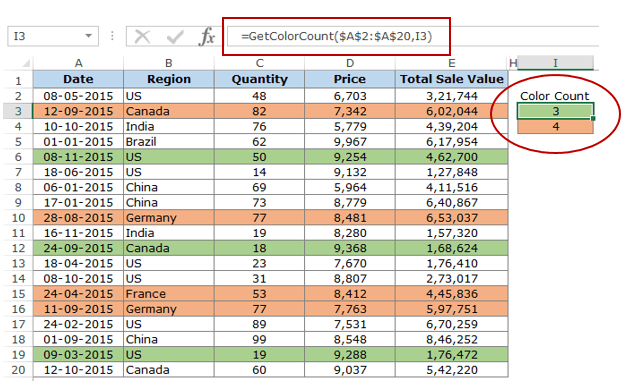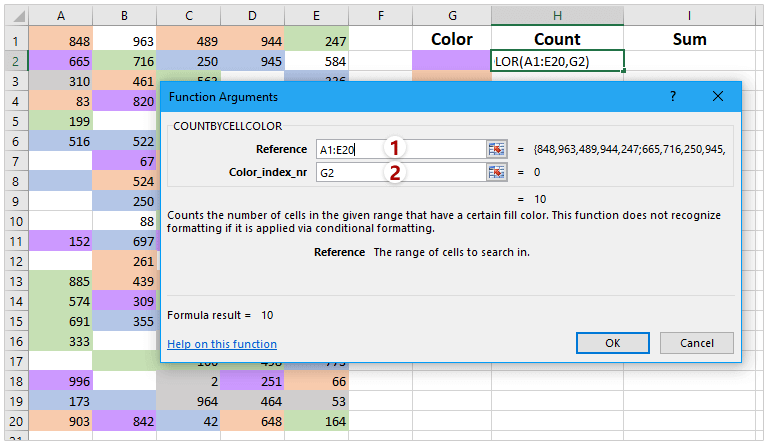

- #How to count a color in excel for mac how to#
- #How to count a color in excel for mac code#
#How to count a color in excel for mac code#
Double click on the module name (by default the name of the module in Module1) and paste the code in the code window. Copy and paste the code in the module code window. In the left pane, under the workbook in which you are working, right-click on any of the worksheets and select Insert –> Module. With your workbook active, press Alt + F11 (or right click on the worksheet tab and select View Code). Here is the code: 'Code created by Sumit Bansal from įunction GetColorCount(CountRange As Range, CountColor As Range)ĬountColorValue = Using VBA, we would create a custom function, that would work like a COUNTIF function and return the count of cells with the specific background color. #How to count a color in excel for mac how to#
In the above two methods, you learned how to count colored cells without using VBA.īut, if you are fine with using VBA, this is the easiest of the three methods. #3 Count Colored Using VBA (by Creating a Custom Function) The COUNTIF function uses the range ($F$2:$F$18) which holds the color code numbers of all the cells and returns the count based on the criteria number. Hence, this color code number is the criteria. The named range in the formula refers to the adjacent cell on the left (in column A) and returns the color code for that cell. The COUNTIF function uses the named range (GetColor) as the criteria. This formula will give you the count of all the cells with the specified background color.
In the adjacent cell, use the following formula:. For example, I used Column A, and hence I will use the cells in column ‘A’ only. Make sure you are doing this in the same column that you used in creating the named range. Somewhere below the dataset, give the same background color to a cell that you want to count. If you follow the above process, you would have a column with numbers corresponding to the background color in it. 
This number is specific to a color, so all the cells with the same background color get the same number. This formula would return 0 if there is NO background color in a cell and would return a specific number if there is a background color. In the cell adjacent to the data, use the formula =GetColor You need to use the reference of the column where you have the cells with the background color. In the above formula, I have used Sheet1!$A2 as the second argument. Let’s deep dive and see what to do in each of the three mentioned steps.
Using the Color Number to Count the number of Colored Cells (by color). Use the Named Range to get color code in a column. Create a Named Range using GET.CELL function. Here are the three steps to use GET.CELL to count colored cells in Excel: See Also : Know more about GET.CELL function. It does not work if used as regular functions in the worksheet. GET.CELL is a Macro4 function that has been kept due to compatibility reasons. #2 Count Colored Cells Using GET.CELL Function If the data if not filtered it returns 19, but if it is filtered, then it only returns the count of the visible cells. The SUBTOTAL function uses 102 as the first argument, which is used to count visible cells (hidden rows are not counted) in the specified range. In the above dataset, since there are two colors used for highlighting the cells, the filter shows two colors to filter these cells.Īs soon as you filter the cells, you will notice that the value in the SUBTOTAL function changes and returns only the number of cells that are visible after filtering. Go to ‘Filter by Color’ and select the color. This will apply a filter to all the headers. Go to Data –> Sort and Filter –> Filter. In any cell below the data set, use the following formula: =SUBTOTAL(102,E1:E20). Here are the steps count colored cells in Excel: There are two background colors used in this data set (green and orange). Suppose you have a dataset as shown below: Use the SUBTOTAL function to count colored cells that are visible (after filtering). To count colored cells in Excel, you need to use the following two steps: 
#1 Count Colored Cells Using Filter and SUBTOTAL
Using a Custom Function created using VBA. In this tutorial, I will show you three ways to count colored cells in Excel (with and without VBA): #3 Count Colored Using VBA (by Creating a Custom Function). Count Colored Cells using the Color Code. #2 Count Colored Cells Using GET.CELL Function. 
#1 Count Colored Cells Using Filter and SUBTOTAL.








 0 kommentar(er)
0 kommentar(er)
